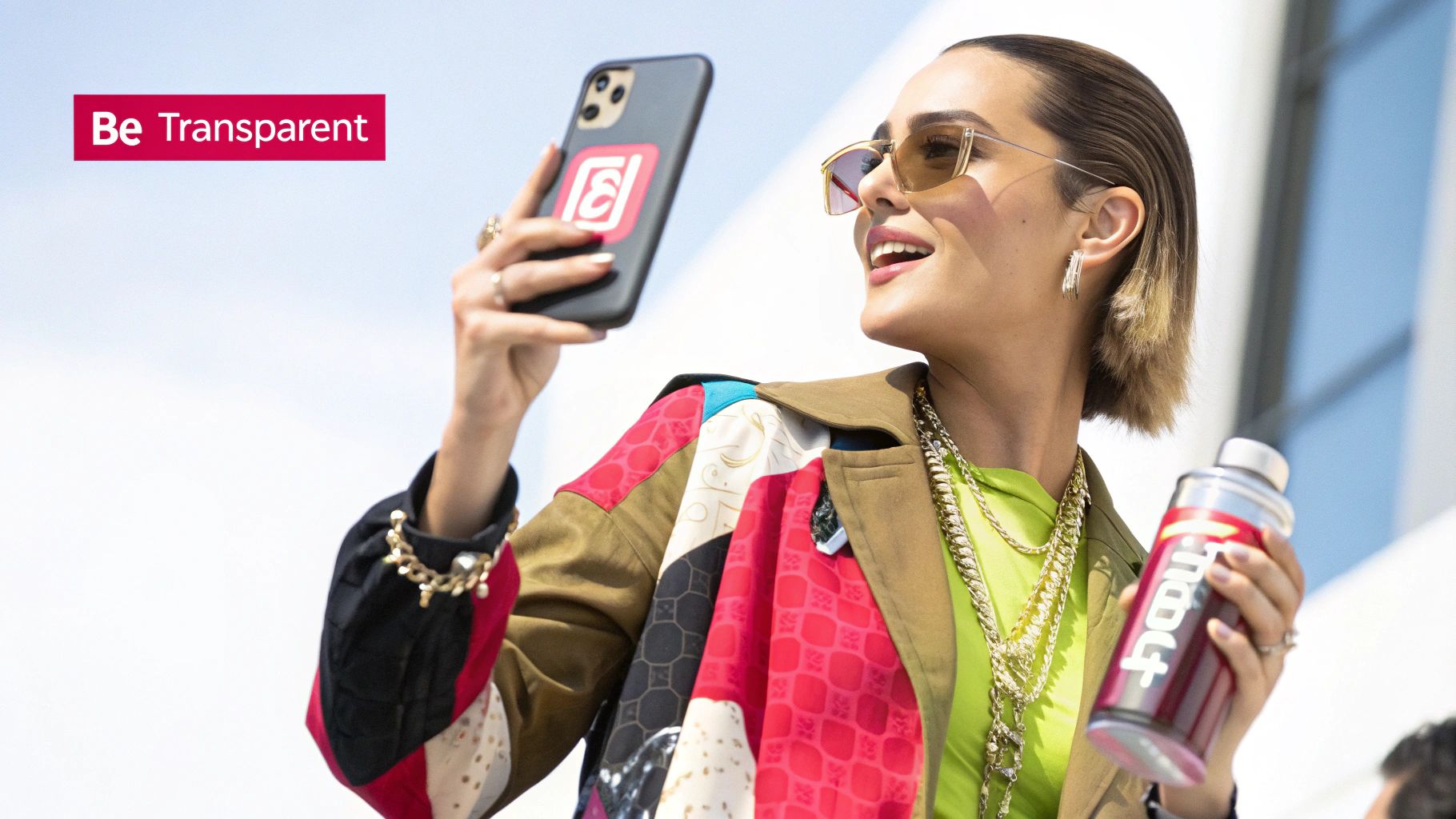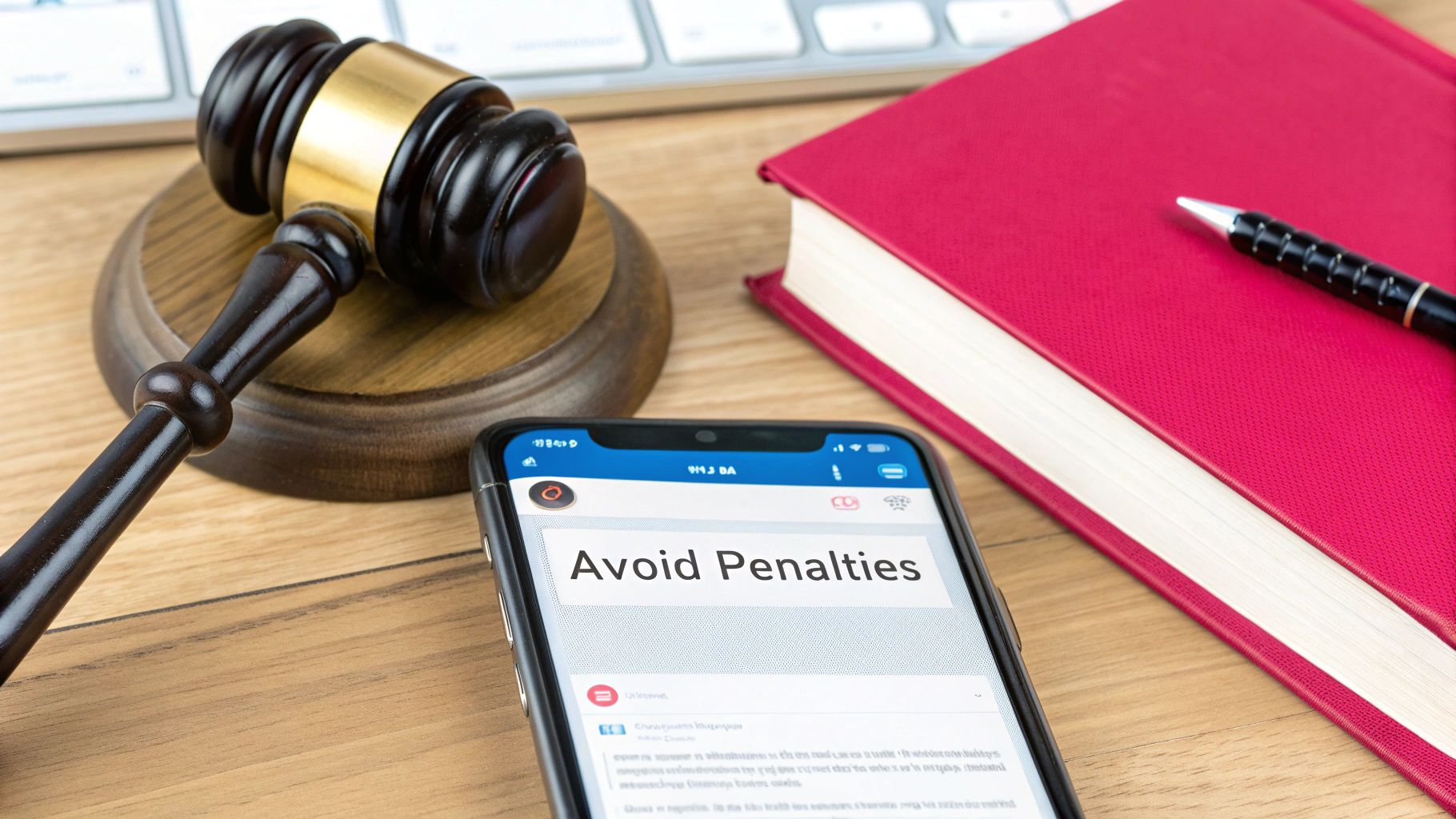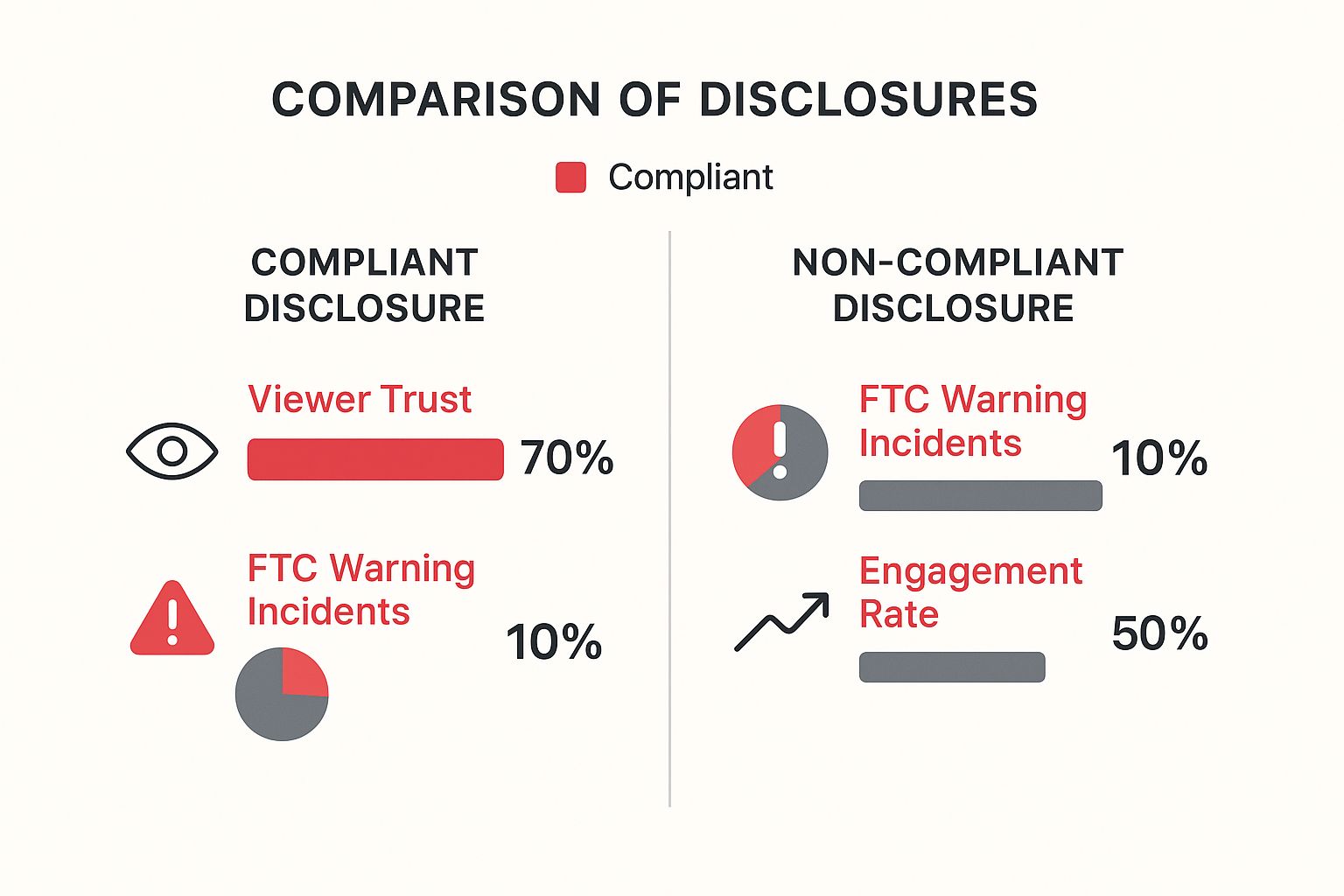 How to Calculate Cost Per Acquisition: A Simple Guide
How to Calculate Cost Per Acquisition: A Simple Guide
Ever wonder why a government agency cares so much about your Instagram posts or TikTok videos? The answer boils down to one simple word: trust. The Federal Trade Commission (FTC) is basically a consumer watchdog, and its core mission is to shield the public from shady or deceptive marketing.
The FTC’s main rule for influencers is straightforward: you have to clearly and conspicuously disclose any material connection you have with a brand you’re promoting. If you got paid, received free stuff, or were given any other kind of perk, your audience has a right to know it’s an ad.
This whole system is built on transparency. When you recommend a product without mentioning you were paid or gifted it, your followers naturally assume it’s a genuine, unbiased opinion. This can mislead them into a purchase they might not have made otherwise. It’s like a friend raving about a new restaurant—their opinion means more if you think they just stumbled upon it, not if you knew the owner slipped them $50 to say nice things.
This logic is part of a wider effort to prevent what are known as unfair commercial practices around the world.
What Counts as a "Material Connection"?
At the heart of the FTC guidelines is the concept of a "material connection." This is the official term for any relationship between a creator and a brand that might influence the weight or credibility your audience gives your endorsement. And no, it’s not just about cash.
A material connection is anything of value you receive from a brand. If knowing about this connection would influence how your audience views your recommendation, it needs to be disclosed.
This idea isn't new. The FTC’s Endorsement Guides have been around since 1980, but they got a major facelift in 2009 to tackle the new world of blogs and social media. That update made it crystal clear that these online relationships count and must be disclosed to keep from misleading people. You can read up on the history of the FTC's revised guides on endorsements directly from the source.
So, what exactly triggers a disclosure? It’s broader than you might think. To make it simple, here’s a quick rundown of the most common material connections that absolutely require a clear disclosure.
Quick Guide to Disclosable Material Connections
| Type of Connection | Example | Is Disclosure Required? |
|---|---|---|
| Monetary Payments | A brand pays you cash for an Instagram Reel. | Yes |
| Free Products | A skincare company sends you their new moisturizer. | Yes |
| Travel & Trips | A hotel comps your stay in exchange for content. | Yes |
| Affiliate Links/Codes | You earn a commission when someone buys with your link. | Yes |
| Contest Entries | You get an entry into a giveaway for mentioning a brand. | Yes |
| Family or Employment | You work for the company, or your spouse does. | Yes |
Ultimately, if a brand gives you anything that could even slightly sway your opinion, your audience deserves to know about it. This isn't about weakening your influence—it’s about strengthening it by being honest. Ignoring this rule is the fastest way to lose your followers' trust, scare away brands, and maybe even get a not-so-friendly letter from the FTC.
Table of Contents
Making Your Disclosures Clear and Conspicuous

Knowing you need to disclose a partnership is just the first step. The real test of your compliance with FTC guidelines for influencers is how you do it. The FTC’s big rule is that every disclosure has to be “clear and conspicuous,” a standard that basically means the average person simply can't miss it.
Think of it like a stop sign. If it’s hidden behind a tree or the letters are too small to read, it’s not doing its job. A disclosure buried in a sea of hashtags, written in confusing jargon, or tucked away behind a "read more" link fails the exact same test. It needs to be right where your audience will see it, in plain language they get immediately.
This isn't about finding a clever way to check a legal box while hoping nobody really notices. The entire point is transparency.
The Anatomy of a Compliant Disclosure
So, what does “clear and conspicuous” actually mean in the real world? While the FTC doesn't give you a script to follow, they are crystal clear on the principles. Your disclosure has to be direct and impossible to overlook. Cutesy or vague terms like “#collab,” “#sp,” or a simple “Thanks, [Brand]!” just don’t cut it. They’re ambiguous and don’t spell out the paid relationship.
According to the FTC, a disclosure is more likely to be effective if it uses simple, clear language that is hard to miss. The burden is on the influencer and the brand to make sure the audience sees and understands the disclosure.
This principle bleeds into placement, too. If your audience has to do any extra work—like clicking a link or scrolling down a bunch—to find your disclosure, you've already messed up.
Common Disclosure Mistakes to Avoid
Plenty of well-meaning creators make simple mistakes that put them on the wrong side of the FTC. These slip-ups usually happen when aesthetics get prioritized over clarity, a decision that can lead to some serious headaches.
Watch out for these common pitfalls:
- Burying the Disclosure: Tossing
#adat the very end of a long string of other hashtags is a classic no-no. Most people will never see it, which means it’s neither clear nor conspicuous. - Hiding It "Below the Fold": You know how Instagram cuts off long captions with a "…more" link? If your disclosure is hidden behind that click, it fails the test. The FTC expects it to be visible without any extra action from the user.
- Using Ambiguous Language: We've said it before, but it bears repeating. Terms like
#ambassadoror[Brand] Partnercan be fuzzy. Your audience might not realize these terms mean you're getting paid. Stick to the obvious. - Relying Solely on Platform Tools: Instagram's "Paid partnership" label and YouTube's "Includes paid promotion" banner are great additions, but the FTC has been clear that they may not be enough on their own. You should still include a clear disclosure right in your caption or video.
Just avoiding these common traps puts you way ahead of the game in following the FTC guidelines for influencers.
Platform-Specific Best Practices
While the core rule of "clear and conspicuous" never changes, how you apply it will look a little different depending on where you're posting.
Instagram and TikTok (Posts, Reels, and Videos):
For any kind of video, your disclosure needs to be a one-two punch: visual and verbal. Overlay text like #Ad or Sponsored right onto the video, making sure it's big enough, clear enough, and stays on screen long enough for someone to actually read it. Then, put that same disclosure at the very top of your caption—before anything else.
Instagram and TikTok Stories:
Stories disappear fast, so your disclosure has to be instantly obvious. Superimpose text like #Ad or Sponsored right on the image or video. Use a clear font that stands out from the background, and be careful not to place it where it might get covered by the platform's own buttons or your username.
YouTube Videos:
A layered approach is your best bet here. Mention the sponsorship out loud, right at the beginning of the video. Back that up with a clear written disclosure like “This video is sponsored by [Brand]” in your video description, making sure it’s high up, above the “Show more” cutoff. Using YouTube’s built-in promotion tool is a smart third layer of protection.
Blogs and Written Content:
For blog posts, your disclosure needs to be at the very top of the article, before the reader gets into the meat of your content. A simple, upfront statement like, “Disclosure: This post is sponsored by [Brand] and may contain affiliate links,” works perfectly.
Learning From Past FTC Enforcement Actions

The best way to really understand why the FTC guidelines for influencers matter so much isn't just to read the rules—it's to look at what happens when people break them. Forget dry history lessons. Think of past enforcement actions as a collection of cautionary tales that show exactly what’s on the line.
When you dig into these cases, you see how the FTC’s oversight has sharpened over the years. It becomes crystal clear that these aren't just polite suggestions.
For a long time, influencer marketing felt like the Wild West, with very few clear boundaries. But as the creator economy matured, so did the FTC’s commitment to applying old-school advertising principles to this new frontier. Their goal has always been the same: protect consumers from being misled.
The Lord & Taylor Case: A Wake-Up Call
The moment theory slammed into reality was in 2016, with one of the FTC's first major crackdowns in the influencer world. The commission went after retailer Lord & Taylor for a campaign where it paid 50 fashion influencers to post Instagram photos of themselves in the same dress.
The problem? No one disclosed that these were paid ads. Thousands of followers were led to believe they were seeing organic, personal recommendations. You can learn more about how this early case shaped FTC enforcement and really set the tone for everything that followed.
This case was a true landmark. It put the entire industry on notice: social media is subject to the same advertising laws as everything else. Both the brand and the creators are responsible for being transparent. It cemented the idea that getting paid—whether with money or free stuff—is a material connection that you absolutely have to disclose.
Broadening Enforcement Beyond The Obvious
Since that first big splash, the FTC hasn't let up. They've steadily widened their net, tackling more nuanced and complex situations. The agency's enforcement history shows a clear pattern of closing loopholes and holding more and more parties accountable.
Here’s a snapshot of how the FTC's focus has evolved:
- Targeting the Middlemen: At first, the focus was on brands and creators. Now, marketing agencies and other intermediaries are also being held responsible for their role in deceptive campaigns.
- Cracking Down on Fake Reviews: The FTC has gone after companies that buy fake positive reviews or suppress negative ones. Just look at the $4.2 million penalty slapped on Fashion Nova for blocking any customer reviews under four stars.
- Warning Specific Industries: The commission isn't shy about proactively warning hundreds of companies in sensitive areas like health and finance, signaling that their claims will be under a microscope.
- Penalizing High-Profile Figures: When the SEC hit Kim Kardashian with a $1.26 million fine for not disclosing a paid crypto ad, it sent shockwaves. It proved that even the biggest stars face serious financial consequences for non-compliance.
These actions prove the FTC is nimble and will adapt its enforcement to new tech and marketing tactics. Whether it's a virtual influencer or a disappearing Instagram Story, the core rule never changes—if it looks like an ad, it needs to be labeled as one.
Understanding these past blunders is non-negotiable for any brand or creator today. They give you a perfect roadmap of what not to do and hammer home the real risk of ignoring the simple demand for honesty in advertising. The message couldn't be clearer: compliance isn't optional, and the FTC is watching.
Of course. Here is the rewritten section, formatted to meet all the human writing, style, and technical requirements.
Handling the Gray Areas: Affiliate Links and Gifted Products
Okay, so we’ve covered the basics. A paid post needs a clear #ad. Simple enough. But what about the situations that aren’t so black and white? This is where many creators and brands get tripped up, and it’s where a real understanding of the spirit of the FTC’s rules becomes your best friend.
We're going to dive into two of the most common scenarios that feel like gray areas: affiliate links and gifted products. Spoiler alert: the FTC sees both of these as a "material connection," just like a cash payment. That means they expect you to be just as transparent.
The Real Deal with Affiliate Links
Affiliate marketing is a fantastic way for creators to earn an income. Someone clicks your special link, buys something, and you get a cut. It’s a win-win, right? But that commission—that direct financial stake you have in their purchase—is exactly why you must disclose it. It’s a connection that could easily influence how much weight your audience gives your recommendation.
Think of it this way: you’re no longer just sharing a product you love. You're now a commissioned salesperson for that product. Because of that, a generic disclosure buried on your website or lost in your bio just won't cut it. The FTC is very clear on this.
The disclosure has to be right there, next to the affiliate link. Your audience needs that context before they click so they can make a fully informed decision. It has to be impossible to miss.
Good disclosures are simple and can’t be misinterpreted. Try these:
- Adding
(affiliate link)right after the link. - Using clear, unambiguous hashtags like #CommissionEarned or #ad.
- Writing a simple sentence like, “Heads up: I may earn a small commission if you buy through this link.”
This isn't about scaring people away from your links. It's about building trust. When you're upfront, your audience appreciates the honesty, and it rarely stops them from making a purchase.
The infographic below breaks down just how much of an impact proper disclosure has on audience trust and engagement.

The data speaks for itself. Clear disclosures lead to higher trust and engagement, all while drastically lowering your risk of getting a warning letter from the FTC.
What to Do with Gifted Products and PR Mailers
Here's another classic situation. A brand sends you a free product, no strings attached. You weren't paid, and you never promised to post about it. But then you try it, you genuinely love it, and you decide to share it with your followers. Do you still need a disclosure?
The answer is a resounding yes.
From the FTC's perspective, that free product is a form of payment. Receiving something of value creates that material connection, regardless of whether a post was part of the deal. Your review can be 100% honest, but the fact that you didn't pay for it could still color how your audience sees your opinion.
So, you absolutely must disclose that the item was a gift. It protects you, and more importantly, it shows respect for your audience's trust.
Handling Tricky Disclosure Scenarios
To make this crystal clear, let's break down these common but sometimes confusing situations and the best way to handle each one.
| Scenario | Key Consideration | Recommended Disclosure Action |
|---|---|---|
| Using Affiliate Links | You have a direct financial incentive tied to a purchase made through your link. | Place a clear disclosure like (affiliate link) or #CommissionEarned right next to the link itself. |
| Posting About a Gifted Item | The brand sent the product for free, but didn't require a post. You chose to share it. | Disclose the relationship clearly. Use simple language like, "Thanks to [Brand] for the gift!" or a clear tag like #gifted. |
| Reviewing a Product You Bought | You purchased the item with your own money and have no relationship with the brand. | No disclosure is needed. Your opinion is entirely organic and independent. |
Once you get the hang of the logic behind these examples, you'll be able to apply the same principles to any new marketing strategy that comes your way. If you’re ever in doubt, remember the golden rule: always choose more transparency, not less.
The Real Costs of Ignoring FTC Rules

Thinking you can fly under the radar with your influencer marketing is a high-stakes gamble. The fallout from sidestepping FTC guidelines for influencers is way more than just a slap on the wrist. It can completely dismantle a creator's career and hit their brand partners with some serious financial and reputational pain.
Make no mistake, ignoring these rules isn't a minor slip-up. It's a direct violation of federal law, put in place to shield consumers from shady advertising. The FTC has a whole toolbox of enforcement actions, and believe me, they aren't afraid to use them.
Financial Penalties and Legal Action
The most immediate consequence of non-compliance is a hit to the wallet. The FTC often starts with public warning letters, which name and shame both the creator and the brand. It’s a permanent red flag for any future partners. But the real pain comes from the civil penalties.
As of 2025, violating an FTC order can lead to fines of over $53,000 per violation. And yes, every single post, story, or video that fails to disclose a "material connection" can be counted as a separate violation.
Just imagine a campaign with ten influencers, each posting twice without the proper disclosures. The potential fines could rocket into the millions. These numbers aren't just hypotheticals, either. In a well-known case, the SEC fined Kim Kardashian a whopping $1.26 million for not disclosing a paid crypto promotion. While the SEC handled that one, it's a stark reminder of the massive financial risks involved with improper endorsements.
On top of the fines, the FTC can mandate strict compliance programs. This means forcing a company into expensive, ongoing monitoring and training to make sure they follow the rules from then on—a costly and exhausting process.
The True Cost of Lost Trust
As steep as the financial penalties are, the most devastating cost of ignoring FTC rules is the complete erosion of audience trust. Your followers' trust is your single most valuable asset. Once it's broken, it is incredibly difficult, if not impossible, to repair.
When your audience finds out you weren't straight with them about a paid partnership, they feel tricked. That authenticity that made your recommendations so powerful in the first place? Gone. One study found that nearly 90% of consumers would lose trust in an influencer they felt was hiding a sponsorship. This isn't just a PR headache; it strikes at the heart of your business.
- Decreased Engagement: Followers who feel betrayed are far less likely to like, comment on, or share your content.
- Lower Conversion Rates: Suddenly, your product recommendations and affiliate links lose their magic.
- Damaged Brand Relationships: Brands will steer clear of creators who have a reputation for being untrustworthy or non-compliant.
Losing trust is like a slow-burning fire that can eventually torch your entire platform. Being proactive about compliance isn't just about dodging fines—it's about protecting the very foundation of your livelihood.
Joint Liability Means Brands Are on the Hook
A lot of influencers make the dangerous assumption that compliance is the brand's problem. That couldn't be more wrong. The FTC is crystal clear that the responsibility for improper disclosures is shared.
Joint liability means the brand, the marketing agency, and the influencer can all be held responsible for a single deceptive post. The FTC expects brands to educate their creators on the rules, monitor their posts for compliance, and step in when violations happen. A brand can't just throw up its hands and claim they didn't know their influencer failed to use #ad. This shared accountability is a powerful reminder that following FTC guidelines for influencers is a team sport. For everyone involved, compliance isn't just a box to check—it's a critical business strategy.
Your Questions About FTC Compliance Answered
Even when you feel like you've got a handle on the rules, weird situations pop up that can make you second-guess yourself. The world of influencer marketing is full of one-of-a-kind scenarios, and trying to apply the core principles of the FTC guidelines for influencers isn't always black and white.
Let's dive into some of the most common questions and sticking points that both creators and brands run into. Think of this as your go-to guide for those "what do I do here?" moments to keep your content on the right side of the rules.
Do I Need to Disclose a Gift If the Brand Didn't Ask Me to Post?
Yes, you absolutely should. A brand might send you a product with "no strings attached," but the moment you decide to post about it, the FTC sees that unsolicited gift as a "material connection."
Why? Because getting something for free, even if you didn't ask for it, can still color your opinion, sometimes without you even realizing it. Your audience has a right to know you didn't pay for it out of your own pocket. Being upfront is always the safest bet.
A simple, honest "Huge thanks to [Brand] for gifting me this!" or a clear hashtag like #gifted or #freeproduct gets the job done. It's all about transparency, building trust, and staying compliant.
If you don't mention it's a gift, your followers will naturally assume you bought it yourself, which makes your recommendation feel different. When in doubt, disclose.
Is Adding #ad to a Long List of Hashtags Enough?
Definitely not. This is a classic mistake, and it's a clear violation of the FTC's rules. The most important standard is that your disclosure must be "clear and conspicuous," and burying it is the exact opposite of that.
Here’s a simple way to think about it: if someone has to hunt for your disclosure, it's not good enough. That means you should avoid:
- Tossing
#adat the very end of a long hashtag pile. - Hiding the disclosure behind a "…more" click.
- Using text colors that camouflage into the background of an Instagram Story.
Your disclosure needs to be somewhere it's practically impossible to miss. For a feed post, that means right at the beginning of the caption. For a Story or video, it should be overlaid directly on the media in big, easy-to-read text.
What Are My Responsibilities for Affiliate Links?
Affiliate links are 100% a material connection and require a disclosure every single time. It's simple: when someone clicks your link and buys something, you earn a commission. That's a direct financial kickback that could influence your opinion, and your audience deserves to know about it.
Just having a general disclaimer on your website or a line in your bio won't cut it. The FTC is very clear that the disclosure needs to be right next to the link itself, giving the user that context before they click.
Here are a few solid ways to do it:
- Direct Text: Add
(affiliate link)right after the link. It's clean and direct. - Clear Hashtags: Use unambiguous hashtags like
#CommissionEarnedor#ad. - An Explanatory Sentence: A simple line like, "Just so you know, I may earn a commission if you buy through my links."
For anyone using affiliate marketing, this level of transparency isn't just a suggestion—it's a must.
Can My Brand Partner Get in Trouble If I Don't Disclose?
Yes, they absolutely can. The FTC considers this a team effort and holds both the influencer and the brand responsible for making sure disclosures are handled correctly. This is a concept called joint liability.
Brands are expected to do their part. That means educating their influencers on the rules, monitoring posts to make sure they're compliant, and stepping in to fix things when they aren't. A brand can't just throw its hands up and say, "It was the influencer's fault!"
The FTC has taken action against brands for the missteps of their creator partners. This is precisely why smart brands bake strict disclosure rules right into their influencer contracts—it protects everyone and shows they take the FTC guidelines for influencers seriously.
Ready to stop worrying about compliance and start scaling your creator collaborations? JoinBrands is an all-in-one platform that connects you with over 250,000 verified creators and streamlines every step of your campaigns, from AI-powered matching to content approval. Find the perfect influencers, manage projects efficiently, and ensure every piece of content is on-brand and compliant. Discover how top e-commerce brands accelerate their growth by visiting https://joinbrands.com today.








